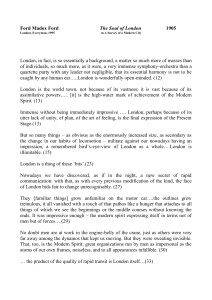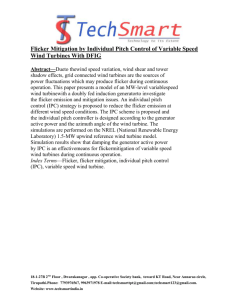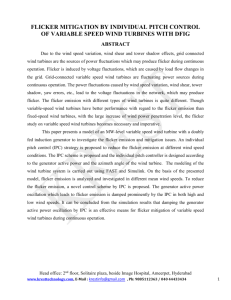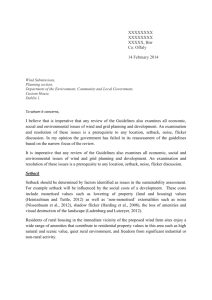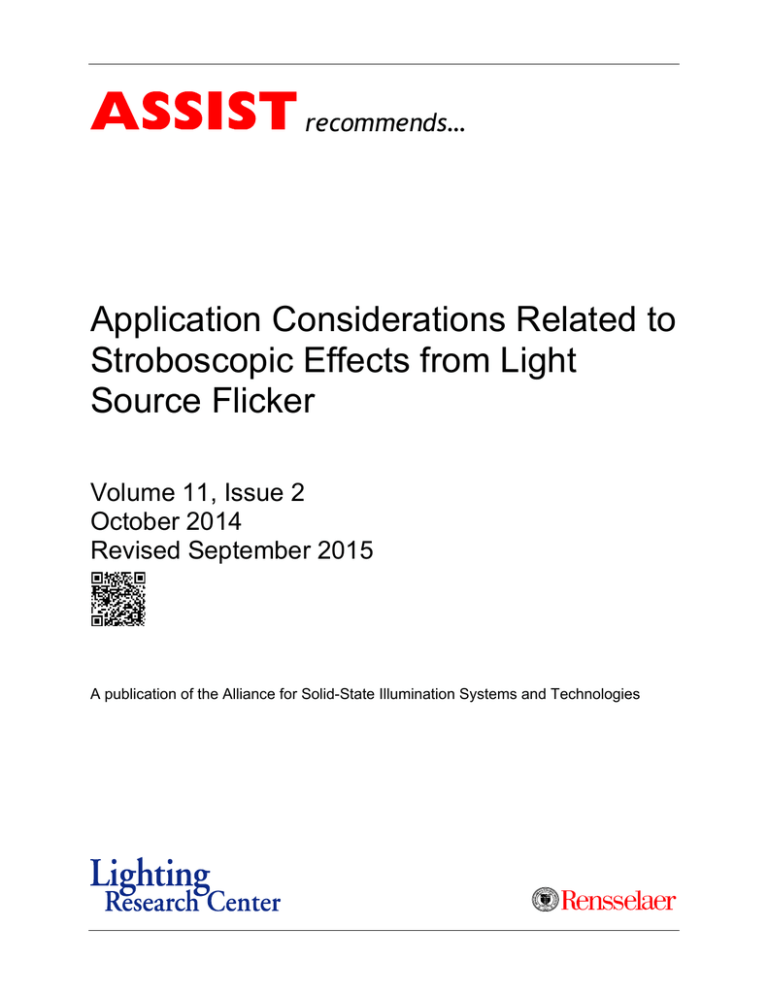
recommends…
Application Considerations Related to
Stroboscopic Effects from Light
Source Flicker
Volume 11, Issue 2
October 2014
Revised September 2015
A publication of the Alliance for Solid-State Illumination Systems and Technologies
recommends…
Copyright © 2014, 2015 by the Alliance for Solid-State Illumination Systems and Technologies (ASSIST).
Published by the Lighting Research Center, Rensselaer Polytechnic Institute, 21 Union St., Troy, NY 12180, USA.
Online at http://www.lrc.rpi.edu.
All rights reserved. No part of this publication may be reproduced in any form, print, electronic, or otherwise, without
the express permission of the Lighting Research Center.
This publication can be cited in the following manner:
Alliance for Solid-State Illumination Systems and Technologies (ASSIST). 2015. ASSIST recommends… Application
considerations related to stroboscopic effects from light source flicker. Vol. 11, Iss. 2. Troy, N.Y.: Lighting Research
Center. Internet: http://www.lrc.rpi.edu/programs/solidstate/assist/recommends/flicker.asp.
ASSIST recommends is prepared by the Lighting Research Center (LRC) at the request of the Alliance for SolidState Illumination Systems and Technologies (ASSIST). The recommendations set forth here are developed by
consensus of ASSIST members and the LRC, but are not necessarily endorsed by individual companies. ASSIST
and the LRC may update these recommendations as new research, technologies, and methods become available.
Check for new and updated ASSIST recommends: http://www.lrc.rpi.edu/programs/solidstate/assist/recommends.asp
ASSIST Members
3M
Legrand
Acuity Brands Lighting
LG Electronics
Amerlux
Lumens
BAE Systems
Lumileds
Bridgelux
New York State Energy Research and
Development Authority
Cirrus Logic
OSRAM SYLVANIA/OSRAM Opto
Semiconductors
Cree
Crouse-Hinds by Eaton
Philips
Dow Corning
POSCO LED
Federal Aviation Administration
Samsung
GE Lighting Solutions
Seoul Semiconductor
Hubbell Lighting
Soraa
Industrial Technology Research Institute
U.S. Environmental Protection Agency
Intematix
LRC Technical Staff
J. D. Bullough, N. Narendran
2
recommends…
Contents
Abstract ......................................................................................................................................................... 4
Document Revision History ........................................................................................................................... 4
Introduction ................................................................................................................................................... 5
Factors Mitigating Visual Responses to Flicker ............................................................................................ 6
Application-Specific Guidance ...................................................................................................................... 8
Additional Considerations for 100-120 Hz Flicker ....................................................................................... 11
Percent Flicker and Flicker Index as Metrics for Stroboscopic Effects ....................................................... 14
References .................................................................................................................................................. 14
Acknowledgments ....................................................................................................................................... 16
About ASSIST ............................................................................................................................................. 16
3
recommends…
Abstract
This issue of ASSIST recommends describes new experimental data that
illustrate how detection and acceptability of stroboscopic effects might change
under different conditions that might be more applicable to certain lighting
applications. Additionally, a framework for evaluating different applications based
on the importance of flicker is provided, with several examples included.
Document Revision History
Summarized below are the major changes made to this ASSIST recommends
document during each revision. The most recent revision supersedes all previous
versions.
August 2015 revision
This revision includes two new sections, entitled "Additional Considerations for
100-120 Hz Flicker" and "Percent Flicker and Flicker Index as Metrics for
Stroboscopic Effects."
4
recommends…
Introduction
As described in ASSIST recommends… Flicker Parameters for Reducing
Stroboscopic Effects from Solid-state Lighting Systems (Bullough et al. 2012a),
nearly all light sources flicker, primarily as a consequence of mains electrical
power systems using alternating current (AC) operating at frequencies at 50 Hz
(in most of the world) or 60 Hz (mainly in North America). AC power at these
frequencies tends to result in light modulation with twice these frequencies (100
Hz or 120 Hz). Light modulation at these frequencies is not directly visible (Kelly
1961; Bullough et al. 2011) but can be perceived indirectly through stroboscopic
effects, at frequencies well above 120 Hz (Hershberger et al. 1998; Bullough et
al. 2011; Perz et al. 2014) and even exceeding 1000 Hz (Bullough et al. 2012b;
Roberts and Wilkins 2013). Stroboscopic effects from flicker can also interfere
with visual performance of some tasks (Veitch and McColl 1995; Jaen et al.
2011; Bullough et al. 2013).
Based on initial findings (Bullough et al. 2011) that the flicker frequency and the
amount of modulation (characterized either by percent flicker [Rea, 2000] or
flicker index [Eastman and Campbell 1952]) were the most important parameters
related to detection of stroboscopic effects, Bullough et al. (2012b) investigated
the detection and acceptability of stroboscopic effects varying in frequency
between 100 Hz and 10,000 Hz, and with the amount of modulation ranging from
5% flicker to 100% flicker (and having flicker indices from 0.03 to 0.5). The visual
task used to assess stroboscopic effects was rapidly waving a white rod back
and forth against a black background underneath a flickering light source, with no
other source of illumination present.
The percentage of times that the stroboscopic effects were detected (d) was
modeled by the following equation:
100%
(Eq. 1)
where f is the flicker frequency (in Hz) and p is the percent flicker value; for the
rectangular, 50%-duty-cycle waveforms used by Bullough et al. (2012b), the
relationship between the flicker index (If) and percent flicker value (p) is given by
(the relationship between flicker index and percent flicker is dependent upon the
specific temporal waveform shape):
2
100%
(Eq. 2)
Bullough et al. (2012b) also asked observers to rate the acceptability of the
stroboscopic effects on a scale of –2 (very unacceptable) to +2 (very acceptable).
The average ratings of acceptability (a) of stroboscopic effects were also
modeled as follows:
4
2
1
130 log10
73
(Eq. 3)
where f and p are defined as above. The rapid, high-contrast task used by
Bullough et al. (2012b) maximized observers' ability to detect the stroboscopic
effects and served as a sort of worst-case scenario for predicting when these
effects could be seen and how acceptable or unacceptable they might be judged.
Yet in many applications, lighting conditions do not maximize perceptions of
5
recommends…
stroboscopic effects. This issue of ASSIST recommends describes new
experimental data that illustrate how detection and acceptability might change
under different conditions that might be more applicable to certain lighting
applications. Additionally, a framework for evaluating different applications based
on the importance of flicker is provided, with several examples included.
Factors Mitigating Visual Responses to Flicker
In order to understand how different aspects of the luminous environment and of
the visual tasks performed in an environment might influence the detection and
acceptability of stroboscopic effects from flickering light, a small human factors
study was performed. In contrast to previous experiments (Bullough et al. 2011;
Bullough et al. 2012b), the present study used light-colored surfaces in the field
of view, and two tasks for the assessment of stroboscopic effects (Figure 1):
Waving a white rod back and forth under the luminaire; this was identical to
the task used by Bullough et al. (2012b) except the background was now
white rather than black, resulting in greatly reduced luminance contrast.
Viewing a mechanical metronome consisting of a specular pendulum bar and
a white-covered tempo scale; the sliding weight of the metronome was
adjusted to its lowest position to produce a rhythm of 208 beats per minute
(about 3.5 Hz). The motion of the pendulum bar was substantially slower
than that of the rod being waved back and forth.
Figure 1. Photograph of test space in the present human factors study.
The illumination in the test space was provided by light-emitting diode (LED)
lamps mounted above the horizontal surface of the test space. The horizontal
illuminance in the center of the horizontal surface was 300 lx. The LED lamps
were controlled by a custom driver that permitted operating the lamps at different
frequencies and different amounts of modulation with rectangular temporal
waveforms having a duty cycle of 50%. For this experiment, the amount of
modulation was always set to 25% flicker, corresponding to a flicker index of
0.13. The frequency could be adjusted to 100, 200, 500 or 1000 Hz. Ten
participants (age 28-52 years, mean 38 years) viewed each of the four conditions
in a randomized order and answered the following questions:
6
recommends…
Did they detect stroboscopic effects when waving the rod back and forth
rapidly?
Did they detect stroboscopic effects when viewing the metronome's
pendulum bar?
How acceptable (–2: very unacceptable to +2: very acceptable) were the
stroboscopic effects, if detected (if not detected the rating was assigned a
value of +2)?
Figure 2 shows the detection percentages for both tasks, and Figure 3 shows the
overall mean acceptability ratings for each of the four experimental conditions.
Worst-case predictions based on the model described by Equations 1 and 3 are
also shown in the figures.
100%
Detection (%)
75%
Metronome
Rod-Low Contrast
50%
Rod-High Contrast (predicted)
25%
0%
0
100
200
300
400
500
600
700
800
900
1000
Frequency (Hz)
Figure 2. Detection percentages (s.e.m.) for stroboscopic effects when waving a
white rod against a white backround (squares) and when viewing the metronome
(diamonds). Also shown (dashed line) are the predicted detection percentages for
waving a white rod against a black background (a high-speed, high-contrast task),
based on Equation 1 (Bullough et al. 2012b).
7
recommends…
2
Low Contrast
Mean Acceptability Rating
High Contrast (predicted)
1
0
0
100
200
300
400
500
600
700
800
900
1000
-1
-2
Frequency (Hz)
Figure 3. Acceptability ratings (s.e.m.) for stroboscopic effects (squares) after
waving a white rod against a white backround and viewing the metronome. Also
shown (dashed line) are the predicted acceptability ratings after waving a white rod
against a black background (a high-speed, high-contrast task), based on Equation 3
(Bullough et al. 2012b).
The data in Figures 2 and 3 show how perceptions of stroboscopic effects are
strongly influenced by the nature of the visual task. In general, detection for the
tasks in the present study are lower than the model predictions, and ratings of
acceptability are slightly higher. For the high-speed, high-contrast task used by
Bullough et al. (2012b) to develop their model, detection of stroboscopic effects
is above threshold (defined as a detection percentage of 50%) for frequencies up
to nearly 1000 Hz. Reducing the contrast reduces the frequency at threshold to
approximately 670 Hz, and reducing the speed of motion results in a very large
reduction in the frequency at threshold, to about 160 Hz. For the ratings of
acceptability, this question was asked after observers performed both visual
tasks in the present study, so the increase in acceptability for data in Figure 3
compared to the worst-case predictions from Bullough et al. (2012b) may be
attributable to either the reduction in speed or the reduction in contrast. The
frequency at which numerical ratings changed between positive and negative
was predicted to be near 130 Hz for the high-speed, high-contrast visual task, but
was reduced to about 90 Hz under the conditions of the present experiment with
the low-contrast background and presence of the lower-speed visual task.
Together, the results of this experiment, in comparison with the model predictions
based on Equations 1 and 3, show how detection and acceptability of
stroboscopic effects can be influenced by the characteristics of the visual task
and the visual environment. Conditions that may be frequently detected and
judged as unacceptable for some applications may be rarely detected and thus
judged as acceptable in others.
Application-specific Guidance
The literature and data described in the previous section of this document serve
to demonstrate that sensitivity to stroboscopic effects from flickering light is not
uniform across all environments and for all visual tasks. For example, in a room
that contains mainly light-colored finishes and in which movement of light-colored
8
recommends…
objects occurs, stroboscopic effects will not be as noticeable as in a room with
the same activity but with dark-colored finishes.
Similarly, the type of task will also influence if, and how, stroboscopic effects from
flickering light are perceived and judged. If a task is largely stationary,
stroboscopic effects are more likely to go unnoticed, but if a task involves rapidlymoving objects it will generally be easier to see.
Table 1 lists several applications and visual tasks that might occur for those
applications. In this table, a relative level of the importance of flicker to the
performance of the task is provided, with justification based on basic or applied
research included. This table provides a simple framework with which lighting
specifiers can assess how critical stroboscopic effects from flicker might be in a
given situation.
Further guidance on the relative importance of flicker and stroboscopic effects is
also summarized in the 9th edition of the IESNA Lighting Handbook (Rea 2000),
Chapter 10, Quality of the Visual Environment. This chapter lists a wide array of
visual tasks for many lighting applications and gives a qualitative assessment of
the importance of flicker and stroboscopic effects for each task. For example, the
importance of flicker and stroboscopic effects is rated as "Very Important" for
tennis, which involves a fast-moving ball, but is rated as "Not Important" for target
shooting, which is performed when primarily standing still. The data from the 9th
edition of the IESNA Lighting Handbook can be a useful first step in evaluating
the sensitivity of various tasks and locations to flicker, which are not listed in
Table 1.
9
recommends…
Table 1. Relative importance of flicker and stroboscopic effects for visual tasks
performed in several different applications.
Application
Industrial
facilities
Office /
school
facilities
Visual Task
Work on
high-speed
equipment
Stationary
work or work
on low-speed
equipment
Computerbased work
Paper-based
work
Basic
orientation
Relative
Importance
of Flicker
High
Medium
When speed of motion is low or
moderate, stroboscopic effects can be
difficult to see at frequencies above 160
Hz (Figure 2 of present document)
Low
Flicker/stroboscopic effects were barely
detectable at 100-120 Hz when working
on computer (Bullough et al. 2011) and
rated very acceptable
Medium
Visual performance of some tasks is
reduced under high-modulation flicker at
100-120 Hz (Veitch and McColl 1995;
Jaen et al. 2011; Bullough et al. 2013)
Low
Flicker/stroboscopic effects were barely
detectable at 100-120 Hz when viewing
stationary objects and scenes (Bullough
et al. 2011)
Low
Flicker modulation at 100-120 Hz is high
with commonly used high pressure
sodium lamps (Navigant 2012) but not
judged to be problematic (Lehman and
Wilkins 2014)
Low
Flicker/stroboscopic effects were barely
detectable at 100-120 Hz when viewing
stationary objects and scenes (Bullough
et al. 2011)
Medium
High-modulation flicker at 120 Hz can be
objectionable to players and/or spectators
(Rea and Ouellette 1988); reducing
modulation at these frequencies
increases acceptability.
Outdoor
locations
Vehicle
driving
Retail /
gallery
spaces
Sports
facilities
Viewing art /
merchandise
Playing
sports
Justification
Stroboscopic effects can be visible at
frequencies exceeding 1000 Hz when
rapid motion is present (Bullough et al.
2012b)
As an example of how a specifier might develop limits in a specific application,
consider stationary or low-speed work as might be performed in an industrial
facility or workshop. Based on Figure 2, stroboscopic effects for low movement
speeds are difficult to detect when the frequency of flicker is above 160 Hz and
the percent flicker is 33% (flicker index of 0.165 for the waveform shape used in
that study). Using the detection prediction model from ASSIST
recommends…Flicker Parameters for Reducing Stroboscopic Effects from SolidState Lighting Systems (Bullough et al. 2012a), the same level of detection is
achieved under the following conditions:
100 Hz, 19% flicker (0.093 flicker index)
120 Hz, 23% flicker (0.117 flicker index)
240 Hz, 53% flicker (0.263 flicker index)
440 Hz (or higher), 100% flicker (0.5 flicker index)
10
recommends…
A specifier could use these values in identifying a lighting system for the
application that would not produce more detectable stroboscopic effects than 160
Hz, 33% flicker (0.165 flicker index).
Similarly, a specifier could use the acceptability data in Figure 3 for applications
involving low movement speed or low-contrast object motion, when high-speed,
high-contrast motion, such as the light-colored rod waved rapidly against a black
background, is not present. Based on Figure 3, a positive average acceptability
rating value is just achieved under 100 Hz, 33% flicker (0.165 flicker index).
Using the acceptability prediction model from ASSIST recommends…Flicker
Parameters for Reducing Stroboscopic Effects from Solid-State Lighting Systems
(Bullough et al. 2012a), the same level of acceptability is achieved under the
following conditions:
120 Hz, 51% flicker (0.255 flicker index)
130 Hz, 65% flicker (0.325 flicker index)
140 Hz, 80% flicker (0.4 flicker index)
150 Hz (or higher), 100% flicker (0.5 flicker index)
A specifier could use these values in identifying a lighting system for the
application that would not produce lower acceptability than 100 Hz, 33% flicker
(0.165 flicker index).
Additional Considerations for 100-120 Hz Flicker
As mentioned above, flicker frequencies of 100 and 120 Hz are common for
many different light sources as a consequence of using 50 or 60 Hz AC for
electrical power. Because flicker at 100 and 120 Hz is common (Bullough and
Narendran 2012), several studies were reviewed to identify the level of
modulation at which flicker at 100 or 120 Hz was either detectable, judged as
problematic, or resulted in negative consequences such as discomfort. These
studies are divided into three application categories as indicated in Table 1,
where flicker is of low, medium, or high importance. Results are given in terms of
percent flicker or flicker index, depending upon the study (some reported both). It
should be noted that most of the studies on the perception of flicker at 100 to 120
Hz have used relatively short exposure durations; the primary exception is the
study by Wilkins and Nimmo-Smith (1989).
Low Importance
Applications for which flicker has low importance (Table 1) include outdoor
lighting, and viewing self-luminous and stationary displays.
Percent Flicker
100% flicker at 120 Hz (Bullough et al. 2011) was undetectable and judged
as very acceptable while performing a self-luminous computer-based task.
Flicker Index
0.5 flicker index at 120 Hz (Bullough et al. 2011) was undetectable and
judged as very acceptable while performing a self-luminous computer-based
task.
11
recommends…
For these applications, the literature does not indicate that lighting conditions
producing 100% flicker or a flicker index up to 0.5 are problematic for the
acceptability of lighting.
Medium Importance
Applications for which flicker has medium importance (Table 1) include reading
and paper-based office tasks.
Percent Flicker
43% flicker at 100 Hz (Wilkins et al. 1989) resulted in higher reported
frequency of headaches and eyestrain than 7% flicker in an office setting.
43% flicker at 120 Hz (Veitch and McColl 1995) resulted in poorer task
performance and lower ratings of visual comfort for a low-contrast paperbased task than low-modulation high-frequency flicker.
90% flicker at 100 Hz (Küller and Laike 1998) resulted in poorer paperbased proofreading performance and less pleasantness than 25% flicker for
some subjects.
32% flicker at 100 Hz (Jáen et al. 2011) resulted in longer paper-based
visual search times and longer paper-based task completion times than 3%
flicker.
100% flicker at 100 Hz (Bullough et al. 2013) resulted in increased error
rates on a paper-based visual task and lower levels of preference compared
to 25% flicker.
22% flicker at 120 Hz (Miller et al. 2013) elicited ratings between moderate
flicker and almost no flicker while 7% flicker elicited ratings between no
flicker and almost no flicker, in an office-type environment.
Flicker Index
0.14 flicker index at 120 Hz (Veitch and McColl 1995) resulted in poorer
task performance and lower ratings of visual comfort for a low-contrast
paper-based task than low-modulation high-frequency flicker.
0.9 flicker index at 120 Hz (Bullough et al. 2011) resulted in lower ratings of
visual comfort than 0.5 flicker index.
0.5 flicker index at 100 Hz (Bullough et al. 2013) resulted in increased error
rates on a paper-based visual task and lower levels of preference compared
to 0.125 flicker index.
0.07 flicker index at 120 Hz (Miller et al. 2013) elicited ratings between
moderate flicker and almost no flicker while 0.02 flicker index elicited ratings
between no flicker and almost no flicker, in an office-type environment.
The median value for which detectable or unacceptable effects were found from
100-120 Hz flicker for these applications was 38% flicker or a flicker index of
0.32.
High Importance
Applications for which flicker has high importance (Table 1) include those in
which high-speed motion is present, such as industrial machinery and some
sporting events.
12
recommends…
Percent Flicker
84% flicker at 120 Hz (Rea and Ouellette 1988) was judged unacceptable by
spectators of a table tennis match, while 51% flicker was judged as
acceptable.
54% flicker at 100 Hz (Bullough et al. 2012) was judged negatively after
rapidly waving an object under a task light, while 25% flicker was judged
positively.
25% flicker at 100 Hz (Bullough et al. 2012) was detected the majority of the
time while rapidly waving an object under a task light.
5% flicker at 120 Hz (Roberts and Wilkins 2013) in a flickering point-source
light could be detected as a phantom array by observers the majority (63%)
of the time.
4% flicker at 120 Hz (Lehman and Wilkins 2014) was reported as the
maximum unnoticeable modulation; 10% flicker at 120 Hz was reported as
the maximum "low risk" modulation.
25% flicker at 100 Hz (Perz et al. 2015) could be detected the majority of the
time while viewing a rapidly moving object under square wave flicker.
Flicker Index
0.25 flicker index at 120 Hz (Rea and Ouellette 1988) was judged
unacceptable by spectators of a table tennis match, while 0.15 flicker index
was judged as acceptable.
0.5 flicker index at 120 Hz (Bullough et al. 2011) was detected the majority
of the time while rapidly waving a hand under a task light.
0.125 flicker index at 100 Hz (Bullough et al. 2012) was detected the
majority of the time while rapidly waving an object under a task light.
0.1 flicker index at 100 Hz (Poplawski and Miller 2013) was judged as the
maximum acceptable value for this frequency.
0.17 flicker index at 100 Hz (Bullough and Marcus 2015) was the value
above which observers judged stroboscopic effects unacceptable after
viewing rapidly moving objects.
The median value for which detectable or unacceptable effects were found from
100-120 Hz flicker for these applications was 25% flicker or a flicker index of
0.17.
Summary
Table 2 summarizes the median percent flicker and flicker index values for each
visual task or application classification (where flicker is of low, medium, or high
importance). These median values could be used as the basis for a specification
of flicker for different task/application classes; using light sources that produce
percent flicker or flicker index values no greater than those in Table 2 could be
expected, on average, to limit the perception of stroboscopic effects.
Table 2. Summary of median percent flicker and flicker index values where
stroboscopic effects were detected based on the literature review.
Relative Importance of
Flicker
Low
Medium
High
Percent Flicker
Criterion
100%
38%
25%
13
Flicker Index
Criterion
0.5
0.32
0.17
recommends…
Percent Flicker and Flicker Index as Metrics for Stroboscopic Effects
As indicated in the previous section, results on the perception of stroboscopic
effects from flickering illumination have been made in terms of percent flicker or
in terms of the flicker index. Bullough and Marcus (2015) conducted a study in
which different temporal flicker waveforms at several frequencies (100, 120, 300
and 1000 Hz) were viewed. In one of their experiments, Bullough and Marcus
compared waveforms all producing the same percent flicker (100%) but with
variations in the flicker index. The results suggested that flicker index was a
superior metric for characterizing stroboscopic effects than percent flicker. This
finding is important because some published specifications for limiting
stroboscopic effects (e.g., IEEE 2015) use percent flicker as the basis for their
recommendations. Specifications based on flicker index will more meaningfully
predict responses to stroboscopic effects than those based on percent flicker.
A weakness of both of these metrics is that they are independent of the
frequency of flicker. For example, stroboscopic effects under a flicker index of 0.3
may be easily detected at 100 or 120 Hz, but may be difficult to detect at 1000
Hz. To facilitate comparisons in flicker index at different frequencies greater than
or equal to 100 Hz, Bullough and Marcus (2015) developed a modified flicker
index, where the flicker index is multiplied by 100/f (where f is the frequency).
They found that conditions with the same modified flicker index values were
equally detectable and judged equally acceptable, even if they differed in
frequency. The modified flicker index provides a way to compare temporal
waveforms that product flicker, independently of their frequency.
References
Bullough, J. D. and D. Marcus. 2015. Influence of flicker characteristics on
stroboscopic effects. Lighting Research and Technology, doi:
10.1177/1477153515599566.
Bullough, J. D. and N. Narendran. 2012. Quantifying stroboscopic effects from
flickering light sources. Council for Optical Radiation Measurements
2012 Annual Conference, Ottawa, ON, May 29-June 1.
Bullough, J. D., K. Sweater Hickcox, T. R. Klein and N. Narendran. 2011. Effects
of flicker characteristics from solid-state lighting on detection,
acceptability and comfort. Lighting Research and Technology 43: 337348.
Bullough, J. D., K. Sweater Hickcox, T. Klein, A. Lok and N. Narendran. 2012a.
ASSIST recommends…Flicker Parameters for Reducing Stroboscopic
Effects from Solid-State Lighting Systems. Vol. 11, Iss. 1. Troy, NY:
Lighting Research Center, Rensselaer Polytechnic Institute.
Bullough, J. D., K. Sweater Hickcox, T. R. Klein, A. Lok and N. Narendran.
2012b. Detection and acceptability of stroboscopic effects from flicker.
Lighting Research and Technology 44: 477-483.
Bullough, J. D., N. P. Skinner and K. Sweater Hickcox. 2013. Visual task
performance and perceptions of lighting quality under flickering
illumination. Journal of Light and Visual Environment 37: 189-193.
Eastman, A.A., and J.H. Campbell. 1952. Stroboscopic and flicker effects from
fluorescent lamps. Illuminating Engineering 47: 27-35.
14
recommends…
Hershberger, W.A., S.S. Jordan, and D.R. Lucas. 1998. Visualizing the
perisaccadic shift of spatiotopic coordinates. Perception and
Psychophysics 60: 82-88.
Institute of Electrical and Electronics Engineers. 2015. IEEE Recommended
Practices for Modulating Current in High-Brightness LEDs for Mitigating
Health Risks to Viewers, IEEE Standard 1789. New York: Institute of
Electrical and Electronics Engineers.
Jaén, E. M., E. M. Colombo and C. F. Kirschbaum. 2011. A simple visual task to
assess flicker effects on visual performance. Lighting Research and
Technology 43: 457-471.
Kelly, D.H. 1961. Visual responses to time-dependent stimuli: I. Amplitude
sensitivity measurements. Journal of the Optical Society of America 51:
422-429.
Küller, R. and T. Laike. 1998. The impact of flicker from fluorescent lighting on
well-bring, performance and physiological arousal. Ergonomics 41: 433437.
Lehman, B. and A. J. Wilkins. 2014. Designing to mitigate the effects of flicker in
LED lighting. IEEE Power Electronics Magazine 1: 18-26.
Miller N. J., M. P. Royer and M. E. Poplawski. 2013. CALiPER Exploratory Study:
Recessed Troffer Lighting. Richland, WA: Pacific Northwest National
Laboratory.
Navigant Consulting. 2012. 2010 U.S. Lighting Market Characterization.
Washington, DC: U.S. Department of Energy.
Perz, M., I. M. L. C. Vogels, D. Sekulovski, L. Wang, Y. Tu and I. E. J.
Heynderickx. 2014. Modeling the visibility of the stroboscopic effect
occurring in temporally modulated light systems. Lighting Research and
Technology 47: 281-300.
Poplawski, M. E. and N. J. Miller. 2013. Flicker in solid state lighting:
Measurement techniques, and proposed reporting and application
criteria. Proceedings of the Commission Internationale de l'Éclairage
Centenary Conference, Paris, France, April 15-16.
Rea, M.S. (editor). 2000. IESNA Lighting Handbook: Reference and Application,
9th edition. New York: Illuminating Engineering Society.
Rea, M.S., and M.J. Ouellette. 1988. Table-tennis under high intensity discharge
lighting. Journal of the Illuminating Engineering Society 17: 29-35.
Roberts, J. E. and A. J. Wilkins. 2013. Flicker can be perceived during saccades
at frequencies in excess of 1 kHz. Lighting Research and Technology 45:
124-132.
Veitch, J. A. and S. L. McColl. 1995. Modulation of fluorescent light: Flicker rate
and light source effects on visual performance and visual comfort.
Lighting Research and Technology 27: 243-256.
Wilkins, A. J., I. Nimmo-Smith, A. I. Slater and L. Bedocs. 1989. Fluorescent
lighting, headaches and eyestrain. Lighting Research and Technology
21: 11-18.
15
recommends…
Acknowledgments
ASSIST and the Lighting Research Center would like to thank the following for
their review and participation in the development of this publication: J. P.
Freyssinier, M. Overington, and J. Taylor.
About ASSIST
The Alliance for Solid-State Illumination Systems and Technologies (ASSIST)
was established in 2002 by the Lighting Research Center as a collaboration
among researchers, manufacturers, and government organizations. ASSIST’s
mission is to enable the broad adoption of solid-state lighting by providing factual
information based on applied research and by visualizing future applications.
16


